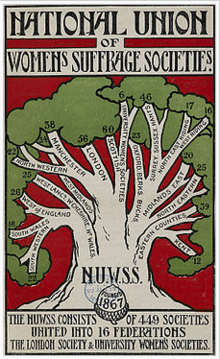|
Florence Annie ConybeareFlorence Annie Conybeare (13 September 1872 – 29 February 1916) was a British campaigner for the Women's Suffrage movement.[1] She was a fundraiser and Voluntary Aid Detachment (VAD) worker during the First World War, and an active member of the Women's Liberal Federation. BirthConybeare was born Florence Annie Strauss on 13 September 1872 in Brixton, London. She was the eldest daughter of Gustave Strauss,[note 1] a German-speaking Bohemian glass merchant [2] and inventor,[3] from Gablonz,[3] North Bohemia, a town known for glass production, who became a naturalised British subject. Her mother, Frances Lehmaier, was born in New York. MarriageOn 15 October 1896 she married the 43-year-old bachelor, former Liberal MP for Camborne, Cornwall, and practising barrister, Charles Augustus Vansittart Conybeare. The marriage was conducted in the Theistic Church[4] and officiated by Charles Voysey, a freethinking Yorkshire vicar who was deposed for publishing heretical sermons and for denying the doctrine of everlasting hell. The Conybeares lived in Cheyne Walk, Chelsea, close to another Women's Rights campaigner, Sylvia Pankhurst, before moving in 1891 to Tregullow House, Scorrier, Cornwall, a country pile owned by John Williams the 5th, a direct descendant of the Williams mining-moguls' dynasty. She remained in Cornwall until at least 1902. The couple later moved to Oakfield Park in Dartford, Kent.[citation needed] Women's suffrage1907: Women's Enfranchisement Bill Conybeare was an active organiser, supporter and voice within the Women's Suffrage movement.[citation needed] She had supported Mr. W.H. Dickenson's[note 2] bill which received its first reading on 8 March 1907. Up to then married women living in the same house were not regarded as 'joint owners' of that property by law. The Dickenson Bill proposed that husband and wife living under the same roof should both be considered as 'joint occupiers' of the property which, as a consequence, would give married women equal status with men and the right to vote. 1908: Women's Suffrage: A Liberal PrincipleIn her ‘treatise’ Some Objections Answered published in 1908,[1] in which she claimed that "Women’s Suffrage is essentially a Liberal principle", Conybeare wrote a reply to an article written by Edith Calkin,[5][6] one of the women critics of Women's Suffrage. She rebuked Calkin for wanting to deny women political recognition and argued why women should be given the right to vote, and aired her objections to Edith Calkin's approach to women's rights. The inequities of legislation
The plight of working women
1913: Suffragist meeting at DartfordOn 24 July 1913, a meeting of the National Union of Women's Suffrage Societies was held in a meadow in Bullace Lane where the Australian suffragist, Muriel Matters, had been invited to address a gathering on the subject of votes for women. Conybeare organised and presided over the event. Her introduction made it clear that they were not militant suffragists, and that they sought to make changes by argument rather than by force.[7] Speech: Australian vs. British suffragism Matters, who had been sentenced to a month in Holloway Prison for obstruction, having earlier chained herself to a grille in the House of Commons, arrived by car with her entourage, as part of a publicity tour around the area, termed a 'pilgrimage'. In her speech, she contrasted the situation in this country with that in Australia where women already had the vote [ed. in 1902, see Women's suffrage in Australia], saying that women in Britain were being treated in the same way as criminals, foreigners and lunatics, despite having to pay taxes. At the end of the speech, Conybeare invited Councillor W.H.D. King to give the vote of thanks. He said that he felt ashamed that he had the vote while they did not, but thanked the party for recognising Dartford as a place of importance worth visiting. Civic workConybeare worked in Voluntary Aid Detachment at Charing Cross Hospital, London.[8] She raised money in Dartford during the First World War for an ambulance.[9] She was president of the Dartford Women's Liberal Association, and had largely been responsible for the setting up and running of the Babies Club.[8] Death Conybeare died at her father's home in Kensington, London, on 29 February 1916, aged 43, after 18 months of failing health, while her husband, Charles Conybeare, was at Canterbury.[8][10] EndnotesReferences
|